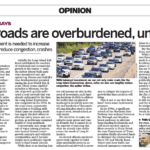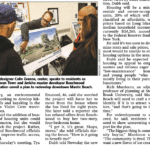From an urban-planning standpoint, the Town of Brookhaven is one of the most interesting municipalities on Long Island.
Standing on the fringe of Long Island’s suburban/rural divide, the township contains some of our region’s last large and vacant parcels that aren’t limited by the Pine Barrens Act. One such parcel will be vacant no more come this fall, when the former Parr Meadows racetrack site in Yaphank that is conveniently located at the LIE and William Floyd Parkway interchange, becomes the site of a 220-room hotel, 850 units of housing, 327,500 square feet of retail, 5,000 square feet of restaurant space and 550,000 square feet of industrial or commercial office space. The town approved the rezoning three years ago, but construction was halted thanks to a lawsuit filed by the Open Space Council over the project’s environmental impacts.
What was always interesting about the AVR Realty Co. proposal was the project’s timing – the zoning was approved right as the town was making a concentrated effort to protect the Carmans River and its surrounding watershed. Since the original effort, the plan has been watered down a bit, but still progress is being made to secure the river’s future for the coming decades. Apparently, progress will also be made at the 322-acre parcel when construction begins.
While the Carmans Plan was being finalized, the town board approved the change of zone that essentially green-lit the project. The true environmental impact of the project, however, is hard to assess. While the project is in the Carmans River watershed, an expansion to the Whispering Pines/Colonial Woods sewage treatment plant is in the works to offset any wastewater impacts. Also, the project site is already disturbed thanks to the prior development. In the late 1980s, controversy enveloped the location when Wilbur Breslin proposed a large regional mall for the site, dubbed Willy World. Several acres of trees fronting William Floyd Parkway were even cleared in anticipation of the project, but as evidenced by AVR’s new project, Willy World never came to fruition.
The lesson to be learned here is that our municipalities are stretched in so many directions that they cannot create a comprehensive land-use strategy. In Brookhaven’s case, the town wanted to have their cake and eat it too. If making an effort to protect the Carmans River, why approve a massive development near its watershed? The difference in philosophy can be explained thanks to a few reasons.
The need for economic development and the dollars it brings is strong. Also helping AVR is a distinct shortage of housing in neighboring Brookhaven National Laboratory, which needs every unit it can get in a relatively sparse area of Suffolk County. Further, the reliance upon property taxes doesn’t exactly inspire the best decision-making by local officials when it comes to land use. Together, these factors contributed to approval. Pair it with murky environmental impacts, and a change of zone was inevitable.
The true impact the AVR proposal will have on the river will be hard to assess, but the philosophy the town (and all other towns on the Island) has toward land use must be more cohesive. While some call for a local approach, we cannot trust the future of the region to be decided by disparate townships looking to stay out of the red. Urban Planning is about balance, but also is about cohesive vision.










